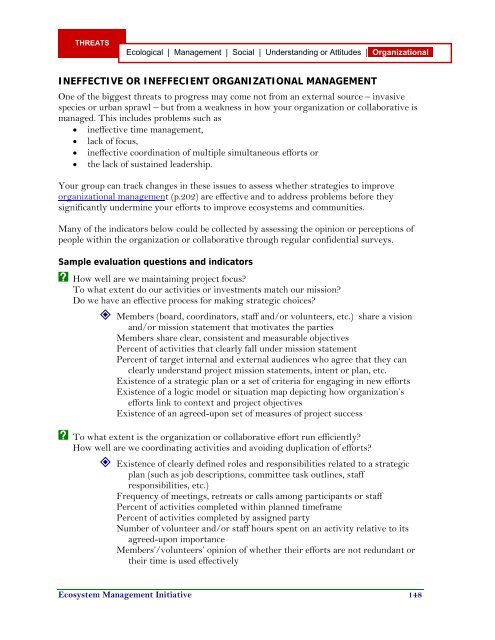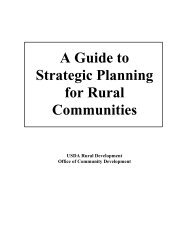Evaluation Sourcebook (.pdf) - School of Natural Resources and ...
Evaluation Sourcebook (.pdf) - School of Natural Resources and ...
Evaluation Sourcebook (.pdf) - School of Natural Resources and ...
- No tags were found...
You also want an ePaper? Increase the reach of your titles
YUMPU automatically turns print PDFs into web optimized ePapers that Google loves.
THREATSEcological | Management | Social | Underst<strong>and</strong>ing or Attitudes | Organizational..Organizational problemsINEFFECTIVE OR INEFFECIENT ORGANIZATIONAL MANAGEMENTOne <strong>of</strong> the biggest threats to progress may come not from an external source – invasivespecies or urban sprawl – but from a weakness in how your organization or collaborative ismanaged. This includes problems such as• ineffective time management,• lack <strong>of</strong> focus,• ineffective coordination <strong>of</strong> multiple simultaneous efforts or• the lack <strong>of</strong> sustained leadership.Your group can track changes in these issues to assess whether strategies to improveorganizational management (p.202) are effective <strong>and</strong> to address problems before theysignificantly undermine your efforts to improve ecosystems <strong>and</strong> communities.Many <strong>of</strong> the indicators below could be collected by assessing the opinion or perceptions <strong>of</strong>people within the organization or collaborative through regular confidential surveys.Sample evaluation questions <strong>and</strong> indicatorsX How well are we maintaining project focus?To what extent do our activities or investments match our mission?Do we have an effective process for making strategic choices? Members (board, coordinators, staff <strong>and</strong>/or volunteers, etc.) share a vision<strong>and</strong>/or mission statement that motivates the partiesMembers share clear, consistent <strong>and</strong> measurable objectivesPercent <strong>of</strong> activities that clearly fall under mission statementPercent <strong>of</strong> target internal <strong>and</strong> external audiences who agree that they canclearly underst<strong>and</strong> project mission statements, intent or plan, etc.Existence <strong>of</strong> a strategic plan or a set <strong>of</strong> criteria for engaging in new effortsExistence <strong>of</strong> a logic model or situation map depicting how organization’sefforts link to context <strong>and</strong> project objectivesExistence <strong>of</strong> an agreed-upon set <strong>of</strong> measures <strong>of</strong> project successX To what extent is the organization or collaborative effort run efficiently?How well are we coordinating activities <strong>and</strong> avoiding duplication <strong>of</strong> efforts? Existence <strong>of</strong> clearly defined roles <strong>and</strong> responsibilities related to a strategicplan (such as job descriptions, committee task outlines, staffresponsibilities, etc.)Frequency <strong>of</strong> meetings, retreats or calls among participants or staffPercent <strong>of</strong> activities completed within planned timeframePercent <strong>of</strong> activities completed by assigned partyNumber <strong>of</strong> volunteer <strong>and</strong>/or staff hours spent on an activity relative to itsagreed-upon importanceMembers’/volunteers’ opinion <strong>of</strong> whether their efforts are not redundant ortheir time is used effectivelyEcosystem Management Initiative 148






